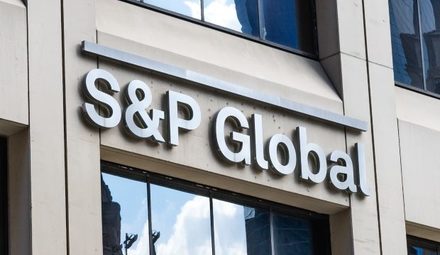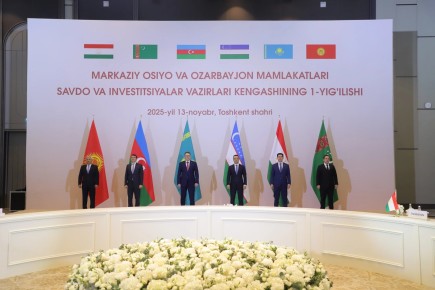On Nov. 21, 2025, S&P Global Ratings raised its long-term foreign- and local-currency sovereign credit ratings on Uzbekistan to 'BB' from 'BB-'. The outlook is stable.
At the same time, S&P affirmed a 'B' short-term foreign- and local-currency sovereign credit ratings on Uzbekistan.
S&P also revised its transfer and convertibility assessment to 'BB+' from 'BB-'.
Outlook
The stable outlook balances Uzbekistan's resilient growth and favorable government debt profile against risks stemming from a rise in broader external and fiscal leverage, if these continue unchecked over the longer term.
Downside scenario
S&P could lower the ratings if external and fiscal deficits weaken beyond its expectations, for instance, due to less favorable terms of trade, higher government spending levels, a material increase in borrowing costs, or a materialization of unforeseen contingent liabilities, given the significant size of the state-owned enterprise (SOE) sector in Uzbekistan.
S&P could also take a negative rating action if growth rates proved significantly weaker than S&P forecast due to lower-than-anticipated economic benefits from debt-financed investment projects or if such projects required significantly higher spending to reach completion, weakening Uzbekistan's fiscal position.
Upside scenario
S&P could raise the ratings if Uzbekistan's budgetary and current account deficits moderated without impairing economic performance.
Rationale
The upgrade primarily reflects what S&P view as sustained improvements in Uzbekistan's macroeconomic policymaking in recent years. Beginning in 2017 with the liberalization of the exchange rate, Uzbekistan's structural reform agenda has increasingly focused on introducing market pricing mechanisms and attracting investment to reduce the state's historically large footprint in the economy. Key measures have included energy tariff adjustments, strengthening the quality of regulatory oversight, a focus on privatizing SOEs, and preparations for World Trade Organization accession in 2026. While privatization has advanced slowly and SOEs continue to play a significant role, the government's reform program, together with resilient household consumption, underpinned by strong remittance inflows and rising wages, should support growth of about 6.3% over 2025-2028.
Ongoing utility tariff adjustments to cost-recovery levels support a reduction in government energy subsidies. S&P note that the authorities started raising electricity and gas tariffs on corporates and households in October 2023, with adjustments continuing through 2025. While these adjustments have temporarily stoked inflation, they have contributed to a steady reduction in state energy subsidies to $0.8 billion (0.7% of GDP) in 2024, down from $1.5 billion (1.4% of GDP) in 2023.
Record gold prices have contributed to a doubling of Uzbekistan's international reserves between 2023 and 2025. As a commodity exporter, the country is currently benefiting from favorable terms of trade, with gold and other metals accounting for about 40% of exports, and from the impact of the revaluation of gold prices on central bank international reserves, of which monetary gold comprises 80%. Although S&P still view balance-of-payments risks as elevated for Uzbekistan amid geopolitical and global trade uncertainty, these risks are partially offset by strong official external funding, the long maturity profile of external debt, and still moderate overall external leverage in an emerging market context. Nevertheless, a persistent and unchecked ramp-up in public sector and external leverage over the longer term could present risks, particularly if debt-financed investment projects fail to deliver the sustainable growth that the authorities expect while adding to borrowing costs.
Its ratings on Uzbekistan also remain supported by the country's track record of resilient growth. Uzbekistan's growth is heavily investment led, with one of the highest investment-to-GDP ratios globally, at about 32%. Together with strong household consumption, this has fueled one of the highest growth rates in the Commonwealth of Independent States (CIS) region.
The ratings remain constrained by Uzbekistan's low GDP per capita, exposure to commodity price volatility, and relatively limited monetary policy flexibility. Gold comprises about one quarter of fiscal revenue, half of merchandise exports, and over three-quarters of central bank international reserves, exposing Uzbekistan's external and fiscal positions to fluctuations in gold prices. However, lower correlation between gold and other metal prices provides some degree of risk hedging. At the same time, geopolitical vulnerabilities remain somewhat elevated, given the economy's reliance on Russia for remittances and trade, which heightens susceptibility to external shocks and secondary sanctions.
Institutional and economic profile: S&P project growth momentum will remain resilient despite global trade tensions
- Uzbekistan has been the second-fastest-growing economy in the CIS in the past decade, but GDP per capita remains relatively low at $3,500 in 2025.
- Broad-based macroeconomic reforms should support the country's investment prospects, albeit from a low base.
- S&P expect decision-making to remain somewhat centralized, and despite recent governance improvements, checks and balances between branches of government remain limited.
Uzbekistan's economic growth has averaged almost 6% annually over the past eight years, since the start of economic liberalization in 2017. Uzbekistan's economy expanded by 7.6% year on year in the first nine months of 2025, compared with 6.6% during the same period in 2024, bolstered by strong performance across a range of sectors, including information and communication, construction, tourism, and trade. High gold prices have also supported currency appreciation and significantly lifted GDP in dollar terms. S&P forecast buoyant growth of 6.3% per year on average over 2025-2028, underpinned by resilient household demand and the government's sizable investments in energy, mining sector capacity expansion projects, and other infrastructure projects, along with social spending. Government measures to stimulate the economy and maintain price stability, such as zero rates on customs duties and regulated prices on certain foods and other key consumer goods, should also boost consumption.
S&P forecast Uzbekistan's GDP per capita will reach $3,500 in 2025, up from $2,000 before the pandemic in 2019, but still low by global standards. About one-quarter of Uzbekistan's population is employed in agriculture, which makes up about 15% of the economy. The country benefits from favorable demographics--almost 90% of Uzbeks are at or below working age--presenting an opportunity for labor-supply-led growth. Nevertheless, S&P anticipate that job growth is unlikely to match demand, and that many of Uzbekistan's permanent and seasonal expatriates will continue to seek employment in Russia and new destinations in Europe and the Middle East, with the economy remaining dependent on remittance inflows.
Public-private partnerships (PPPs) have expanded rapidly, with the total value of signed contracts amounting to an estimated 27% of GDP at end-2024. The government has approved a further pipeline of approximately $30 billion in PPP projects over 2024-2030, concentrated in strategic sectors such as energy (93% of projects), including renewables (83% of all energy projects). The authorities plan to diversify and modernize electricity generation, particularly through green energy, with the goal of raising renewables to 54% of the energy mix by 2030, from about 20% currently. Notably, Saudi Arabia's ACWA Power intends to invest $7.5 billion in electricity generation projects in Uzbekistan through 2030. S&P note that a newly adopted PPP framework should limit future commitments, including a cap of $6.5 billion in 2025, but unforeseen project failures could still weigh on public finances over the longer term. The authorities estimate direct and contingent liabilities stemming from the PPP projects at about 15% of GDP.
Structural reforms are underway to reduce the footprint of the state in the economy, but S&P expect progress to be comparatively slow. State asset privatizations reached $3.7 billion between 2021 and the first half of 2025 (3.2% of GDP), with the largest sale being a controlling stake in Ipoteka Bank in 2023 (prior to privatization, the fifth-largest state-owned bank in the country). That said, the privatization process has progressed more modestly than initially envisioned, owing to restructuring delays, capacity constraints, and external shocks tied to the pandemic and the Russia-Ukraine conflict (see "Uzbekistan's Bank Privatization: An Extended Journey," Sept. 19, 2025). Still, S&P expect the authorities will remain committed to reducing the dominant role of SOEs--around 1,800 entities (of which over 95% are small in size)--within the economy. This commitment is underscored by the establishment of the National Investment Fund (UzNIF) in 2024, managed and administered by asset management firm Franklin Templeton, which intends to list the shares of 15 major SOEs and banks on domestic and international stock exchanges.
Under a scenario of a ceasefire between Russia and Ukraine, Russia-related trade and capital flows through Uzbekistan could be affected, but S&P expect the broad economic impact to be contained. Since 2022, the economy has absorbed spillover effects from the war relatively well. Remittance inflows surged by 27% year on year to $8.2 billion (7.1% of GDP) in the first half of 2025, supported by sustained labor demand and higher wages in Russia (78% of remittances stem from Russia), digitalization of money transfer routes, and growing diversification of remittance sources from the U.S., Germany, Poland, and South Korea. Trade with Russia also expanded by roughly 5% year on year to $6.0 billion (5.2% of GDP) in the first half of 2025.
Although the authorities continue efforts to comply with sanction requirements, risks persist that the U.S. and EU could impose additional secondary sanctions on Uzbek companies engaged in business with Russia . This is evidenced by past measures against private Uzbek firms engaged in trading electronic and telecommunications equipment and defense-related goods. However, there have been few sanctions-related cases since 2022.
Despite macroeconomic policy improvements, Uzbekistan's broader institutional arrangements remain comparatively weak. A new constitution adopted in May 2023 lengthened the presidential term of office to seven years from five and allows the current president, Shavkat Mirziyoyev, to remain in power until 2037. In its view, government policy responses can be difficult to predict, considering the relatively centralized decision-making process. Moreover, while perceptions of corruption are improving, they remain elevated compared with peers at similar rating levels.
Flexibility and performance profile: S&P forecast government and broader external debt will continue rising at a moderate pace
- S&P anticipate that public development plans, which require sizable debt-financed investments, will continue to place upward pressure on net general government debt and borrowing costs over the medium term.
- Uzbekistan's debt profile remains favorable, with a large proportion of total debt on concessional terms (84% of total external debt).
- Although monetary policy effectiveness has improved in recent years, S&P still consider the Central Bank of Uzbekistan's (CBU's) operational independence to be constrained and loan dollarization remains elevated, at about 40% of total loans.
The authorities remain on track to achieve their headline fiscal deficit target of 3.0% of GDP in 2025. All-time-high gold prices are supporting Uzbekistan's fiscal receipts through higher corporate income tax and mining tax revenue and dividends. On the expenditure side, S&P expect energy tariff liberalization to deliver fiscal savings of about 1% of GDP this year, while ongoing efforts to target social spending should help contain spending. S&P forecast that still favorable commodity prices and ongoing budget consolidation measures will support deficits of an average of 3% of GDP annually over 2025-2028, slightly lower than 4% of GDP recorded over 2022-2024. Nonetheless, fiscal outcomes remain subject to downside risks, particularly given the historically procyclical nature of social protection spending, including government wages, which account for about 50% of expenditure and are politically difficult to adjust.
Although Uzbekistan's reported headline deficits averaged 4% of GDP in the past three years, S&P note that net general government debt increased at a faster pace of over 6% of GDP. In recent years, the government has significantly ramped up spending on energy, mining capacity expansion, infrastructure, and social programs. Some of this has been extended through guarantees and on-lending via SOEs, which does not require government spending, and is therefore not accounted for as such under reported headline fiscal statistics. Given that about 84% of Uzbekistan's government debt is denominated in foreign currency, a gradual depreciation of the Uzbekistani sum has also contributed to government debt increasing at a faster pace than implied by the reported deficits.
S&P project that continued public investment will push net general government debt to about 35% of GDP by 2028, compared with a net asset position in 2017. Its debt projections incorporate government-guaranteed debt (5.5% of GDP in 2024), reflecting Uzbekistan's close ties with government-related entities (GREs). In addition, S&P see some risk that non-guaranteed GRE debt could crystallize on the sovereign balance sheet (5.0% of GDP in 2024). To minimize this risk, the government has recently implemented a system for monitoring and analyzing covenant requirements in SOEs’ loan agreements.
Uzbekistan's debt profile remains predominantly concessional, but commercial issuance has been increasing. Uzbekistan owes most of its foreign debt to official lenders (84% of total external debt), on concessional terms with long tenors. To mitigate currency risk and foster domestic capital market development, the government has shifted toward greater reliance on domestic borrowing, with the share of local currency debt rising to 12% of total debt in 2024, up from 8% in 2022. S&P expect that the growing dependence on domestic and commercial external issuances will lift interest payments to about 4.4% of general government revenue over 2025-2028, compared with just 0.6% in 2019. In its view, this is still a low level in an emerging market comparison.
The government's liquid assets fell to 9% of GDP in 2024, down from 33% of GDP in 2017. Most of these assets are concentrated in the Uzbekistan Fund for Reconstruction and Development (UFRD), which was founded in 2006. The UFRD was initially funded with capital injections from the government, as well as revenue from gold, copper, and gas sales above certain cut-off prices, until 2019. When calculating government liquid assets, S&P include only the external portion of UFRD assets. The domestic portion consists of loans to GREs and capital injections to banks, and S&P consider it to be largely illiquid and unlikely to be available for debt service. In addition, S&P exclude UFRD external assets from the CBU's usable reserves because S&P consider that the former are primarily held for fiscal reasons, rather than to support monetary or balance-of-payments needs. Its view is supported by the budgetary use of UFRD assets in the domestic economy in recent years.
Record-high gold prices are providing a boost to Uzbekistan's exports and international reserves. Commodities, and particularly gold, account for 40% of goods exports, while monetary gold holdings represent about 80% of the CBU's usable reserves, thereby benefiting from valuation gains linked to higher prices. That said, S&P understand that such gold holdings can be readily liquidated through international metal exchanges should the need arise. S&P project usable reserves will peak at $55 billion at end-2025 before declining through 2028, reflecting its assumption of falling gold prices to $3,300 in 2026, $2,600 in 2027, and $2,300 in 2028, from an average of around $3,400 in 2025 (see "S&P Global Ratings' Metal Price Assumptions: Gold Powers Higher, Copper Jumps," Oct. 13, 2025).
Structurally high current account deficits and rising external debt could heighten balance-of-payment risks for Uzbekistan over the medium term. S&P forecast the current account deficit will widen to about 5.7% of GDP by 2028, from an estimated 3.2% in 2025, reflecting a relative normalization of remittance inflows and a gradual decline in gold prices. S&P also expect import growth to remain elevated, driven by the sizable pipeline of investment projects. Moreover, Uzbekistan became a net importer of gas in October 2023 following the start of Russian gas imports via Kazakhstan. S&P anticipate that the current account deficit will be financed primarily through concessional external debt and, to a lesser extent, foreign direct investment inflows.
Uzbekistan's monetary policy effectiveness has strengthened in recent years, but shortcomings remain, including shallow domestic capital markets and elevated dollarization levels. The CBU intermittently intervenes in the foreign exchange market to smooth volatility, primarily through large gold purchases. With priority rights to domestically mined gold, the CBU acquires gold in local currency and subsequently sells U.S. dollars in the domestic market to offset the impact of its interventions on the Uzbek som. S&P expect ongoing increases in energy tariffs to keep inflation elevated at almost 9% in 2025, compared with an average of 11% over 2020-2024, before gradually declining to about 8% by 2028. To counter inflationary pressures, the CBU raised its policy rate by 50 basis points to 14% in March 2025.
S&P expect Uzbekistan's banking sector to remain resilient. S&P consider that favorable economic growth prospects, strengthening disposable incomes, and low financial inclusion, including penetration of retail lending in Uzbekistan (with household debt to GDP below 10% of GDP), will remain among the key factors contributing to further growth of banking business and strong demand for lending in the next few years. The largest Uzbek state-owned banks and the few privately owned banks have stable and diversified funding profiles, supported by sizable long-term funding from the state, international financial institutions, and external capital markets. However, S&P view the steadily growing domestic deposit base as insufficiently large to cover banks' financing needs, especially for long-term funding, while the local capital market also remains small and shallow. S&P continue to see bank regulation in Uzbekistan as reactive, rather than proactive. Regulatory actions are not always predictable and transparent, but regulation is gradually improving.
State-owned banks dominate the sector and hold 65% of total assets, which distorts the operating environment. This, combined with preferential government lending programs, reduces the effectiveness of the monetary transmission mechanism, in its view. The privatization of Uzbekistan's state banks is taking longer than the government initially envisioned. Following the sale of Ipoteka Bank in 2023, the authorities now plan to privatize two large state banks: SQB and Asaka. However, S&P expect it will take time, as further progress will depend on various factors including the transformation of state banks to make them more efficient and profitable, continued engagement with the market on the government's modernization plans, and alignment on asset valuations.
To address very strong growth in consumer loans over the past few years, the central bank has implemented more stringent lending requirements. These include limits on car loans, cash loans, and credit card and overdraft loans in total banks' loan portfolios and tighter debt service-to-income limits for retail borrowers. Although dollarization is declining thanks to CBU policies, it remains high: about 37% of loans and 25% of deposits were denominated in U.S. dollars as of end-October 2025.












